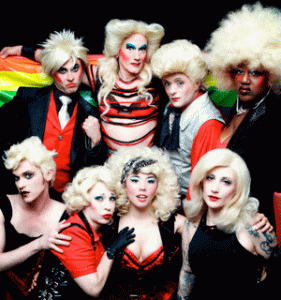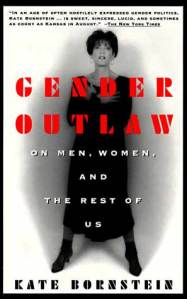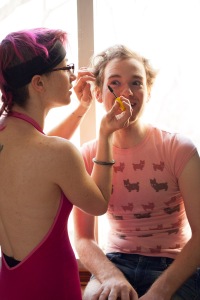The first time I saw Hedwig was in Atlanta. It would have been in the early mid-oughties, and my husband-at-the-time spent most of the show leaning back in the chair with his “I’m very uncomfortable about this level of social interaction!” face on, as Hedwig Robinson took an inordinate interest in him and spent much of the show sitting in his lap.
After that, I watched the movie. And loved it.
It struck something inside me that I don’t think I could even elucidate: I’m a white, middle class, cisfemale who identifies as straight, what do I know about what it’s like to be that different? I went through some teasing in elementary school, sure, but nothing compared to being wholesale rejected for who I fundamentally AM. The music of Hedwig, though, was catchy and gorgeously sad, with clever lyrics, just the way I like it. Hedwig goes from naive and trusting girly-boy who believes wholesale that there is another, perfect half out there that can complete you…to realizing, ultimately, that the only person who can complete you is yourself. The more time you spend running from yourself, the less time you spend being whole. I could get behind that: I definitely don’t believe love is the answer (what was the question?), and John Cameron Mitchell’s glam rock opera about an East German botched transexual was still, somehow, about me. “Know in your soul/like your blood knows the way/from your heart to your brain/know that you’re whole,” Hedwig sings, all artifice stripped away.
The movie was also hilarious and filled with the sort of bizarre glam-rock radical faerie costuming that I’d eventually come to expect as normal from my social group (I have one friend who identifies as a mermaid, for example). I was hooked on Hedwig.
Since then, I’ve watched the movie at least once a year. The album is on permanent repeat in my iPod — yes, the original cast recording too, which is actually basically the same as the movie soundtrack. I saw the stage show again last year in London, Ontario (of all places)…and then a friend told me the show had been mounted for a longterm run at Boxcar Theatre in SF. I was going to SF for the IASHS SAR. It wasn’t even a question about buying tickets.
The show runs in a nightclub-style space dotted with small tables, some of which have innocuous defining characteristics: one has a stripper pole through it, for example. An older couple sitting next to me were on their twelfth time seeing the show and the man, after taking a healthy swig of his drink, told me he’d make sure to point out any important staging points so I didn’t miss anything.
The show was both familiar and unfamiliar — familiar because of course, the songs and the plot and most of the dialogue are the same, although the cast or director have changed some of the locational details to reflect San Francisco rather than New York. Hedwig related the story of her life…or should I say HEDWIGS relate the story of their life, because the role of Hedwig is split into 8 different actors. Some are men, some are women, of every size and shape and glam rock costumery. With an enthusiastic elbow to the side, the older man next to me pointed out when one Hedwig would apper on the stage blacony as another one squirted whipped cream into an audience member’s mouth. “That guy’s been here over twenty times,” my new friend whispered and nodded at the creamed-up dude, who was singing enthusiastically along with every word of every song.
The eight Hedwigs sang, sometimes in chorus and sometimes solo, but the real standout performance of the show was Amy Lizardo as the impassioned Yitzhak. I found myself preferring her rock-solid, consistent presence to the constantly-changing Hedwigs. I understand why director Nick Olivero chose to split Hedwig into so many parts: it’s stated outright at the beginning of the show, that Hedwig has many facets and many life paths…we all contain multitudes. But several things about this choice didn’t work for me: Hedwig is an eminently tragic, believably-flawed character. She contains those multitudes with panache, even when she struggles against her goals, or the unfairness of life. I found it hard to find as much sympathy when the character is split into so many segments, underlining Hedwig’s fractured nature. She is so fractured, in this show, that you can’t quite follow what she is doing. It’s hard to have a lonely heroine when she is surrounded by movement and other voices.
Augusten Burroughs’ book “This is How” touches on something I think is relevant to this idea as well: that only in moments of great loss can we actually become whole. You grow most effectively through hardship. When Hedwig leaves Berlin for Junction City, she is still unfinished, the tattoo on her hip reflecting that fractured face…searching for its other half to join with. But at the end of the show, when she has truly lost not just Tommy but her own walled-up, precarious sense of self, and must find out from the beginning who she really is? That’s when the tattoo (and Hedwig herself) becomes whole. Hedwig’s split into multiple actors diminishes this journey by compartmentalizing it: oh, that fight with Tommy happened to THAT Hedwig, but not THAT one. How can Hedwig become whole when she is quite literally broken up into parts?
The decision to have the songs sung as choruses in some cases strengthened the show, but also sometimes made it overwhelmingly rock-y; for the power songs, this was fine, but the quiet, persistent acoustic-y songs were overwhelmed by this many voices. Also, some of the actors were more proficient singers than others, which lends some songs a bit of an uneven feeling. The music performances and staging were excellent, though, and I was overjoyed by the audience interactions.
Hedwig inspires loyalty, the kind of root-deep, remarkable loyalty that makes people follow Jimmy Buffet to Vegas. That dude wasn’t the only one singing along: so was I, so were the middle-aged guys at the very front table, so were the twelve-times couple sitting next to me. This show displays the heart of its title character: Hedwig Robinson in all her achey, imperfect glory. You feel so much for her because she is so imperfect, stumbling through life in search of something that doesn’t even exist (true love), ricocheting from trauma to trauma, only to finally be faced with the cold truth that she is the only one she will have to life with for the rest of her life. Boxcar’s Hedwig(s) do reflect this — and there are some truly standout moments around the staging and multiple cast member interactions — but left me feeling a bit more disconnected from Hedwig than I have before.
Don’t get me wrong: I really liked the show. I thought it was vivacious and enthusiastic, and there were some truly stellar singers in the company, including the bit parts, like Tommy Gnosis. Everybody did a bang-up job. I just didn’t LOVE it…although I would go see it again. If you’re in the Bay Area, I’d suggest you go see it for yourself and tell me what you think: the production is set to finish on August 10, so buy tickets soon or you’ll miss your shot to see an independently-produced Hedwig before Neil Patrick Harris takes it to Broadway and nobody can afford to see it anymore.




